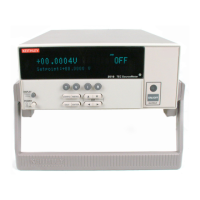4-10 PID Control Concepts Models 2510 and 2510-AT User’s Manual
Practical autotune considerations
There are several practical considerations to take into account when using autotune. Each
of these is outlined below.
TEC module gain
The gain of a TEC module varies with operating temperature and increases with increas-
ing temperature. This variation can be as much as 7:1 over the operational temperature
range of the device. The principle reason for this change in operational efficiency is that
the I
2
R heating generated by the normal operation of the Peltier junction adds to the effi-
ciency of the junction when pumping heat into the load, but it subtracts from the efficiency
of the junction when cooling the load. This change in Peltier gain will cause the overall
system characteristics (and hence the tuning constants which will control it) to change
appreciably over the entire operating temperature range of the system. It is for this reason
that you should tune the PID loop at the actual system operating temperature. Ideally, if
the temperature changes by more than 10°C, you should create a new set of tuning con-
stants for proper control.
Large temperature steps
If the temperature step is very large, tune the PID loop at the highest temperature that will
occur during normal operation. This tuning method will ensure stability of the PID loop at
the higher operating temperatures. If you use these same tuning constants at the lower
temperatures, response at the lower temperatures will be slower (due to the lower gain of
the TEC). If the loop is tuned at the lower temperatures (to give a better response), and
these same tuning constants are used at the higher temperatures, the PID loop may become
unstable at the higher operating temperatures (due to the higher gain of the TEC at these
higher temperatures). Averaging the constants from both extremes is not advisable as poor
performance will result at both operating points — more overshoot and ringing at high
temperatures; slower response at lower temperatures.
PID fine tuning
If the autotune algorithm does not yield the desired response, use the PID loop constants
created by the autotune algorithm as a starting point, and modify them as needed to obtain
the desired performance. The three PID loops constants perform the following functions:
• Kp (Proportional gain constant) — This constant “pushes” the system to its final
value. Lower numbers create a slower response while larger numbers help increase
the response speed. Values too large may cause the system to oscillate and/or
become unstable.
• Ki (Integral gain constant) — This constant is responsible for how fast the system
settles to its final value, as well as how much overshoot occurs. Low values create a
long settling tail with minimal overshoot, while large values settle much more

